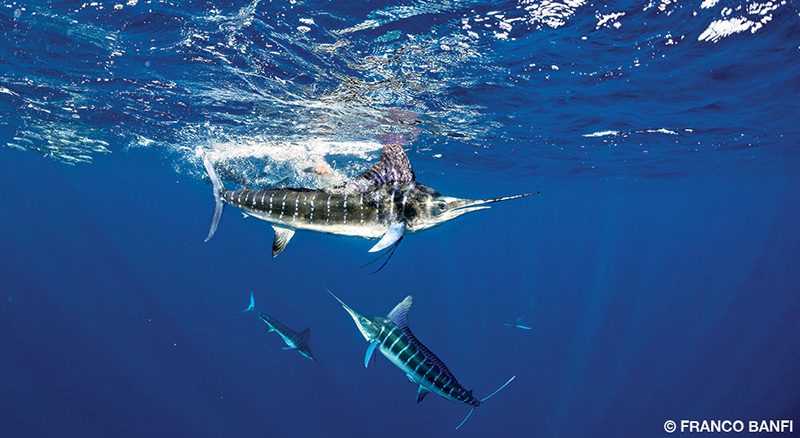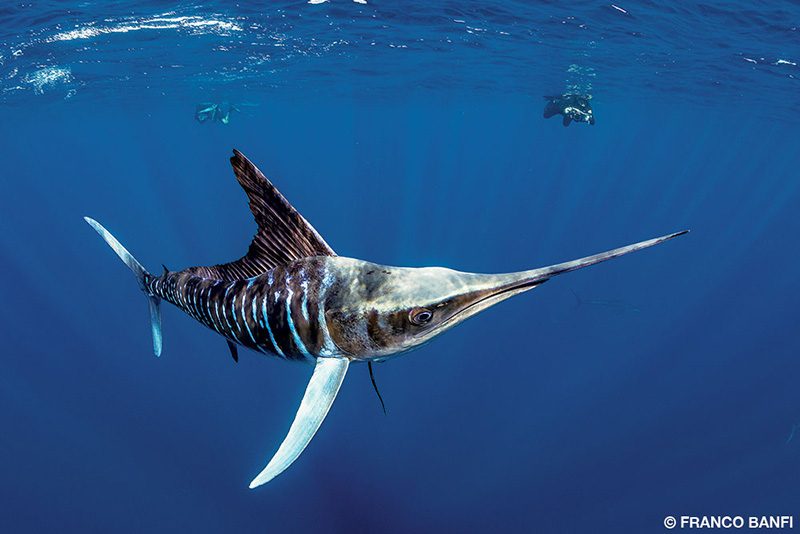Seizing a fleeting photographic opportunity
An elongated ocean fish with a tall dorsal fin, the fascinating striped marlin (Kajikia audax) can be challenging to document. As a photographer, I’m interested in its ability to change the color of its vertical bars, shifting from dark blue to phosphorescent blue or lavender in the blink of an eye. The expansion or contraction of special pigmented cells called chromatophores creates this natural light show when the fish gets excited, such as when feeding or trying to attract a mate.
As a diver and a swimmer, I’m fascinated by the striped marlin’s ability to swim long distances and at average speeds reportedly up to 50 miles per hour — similar to its cousin, the blue marlin; it is bested among fish only by the sailfish and perhaps the black marlin. Its anatomy, with elongated tail lobes that reach undisturbed water beyond the turbulence its body creates, helps to power this exceptional swimmer.
Another exceptional characteristic of striped marlin is their growth rate, which is among the fastest of all bony fish. Growth is particularly rapid during the first two years of life. Contributing to this fast growth among billfish and large-bodied tuna is their ability to deliver oxygen and metabolic substrata to tissues at a high rate more akin to mammals than fish. An advantage of this high-performance physiology is a rapid rate of tissue turnover, which facilitates equally rapid rates of somatic growth. Juvenile growth rate and large maximum body size are selective for open-ocean fish because of the long distances between feeding and spawning grounds and the difficulty for vulnerable juveniles to avoid predation.
Distribution
Striped marlin, which can swim thousands of miles and are found in the vast tropical and subtropical oceans, are apex predators that feed on the fastest prey. They are a highly migratory, broadly distributed pelagic species, showing considerable variation in spatial distribution because of habitat preference. They are found in more temperate waters than other billfish.
Climate change due to anthropogenic impacts is affecting the global oceans, particularly causing increased water temperatures and negatively affecting marine ecosystems. Due to their highly migratory nature, large pelagic species such as tuna and billfish are likely to change their distribution in response to climate-related environmental variability before other fish species. A reasonable assumption is that future increases in sea surface temperatures will lead to a northward displacement of striped marlin in the northern Pacific Ocean.

Studies of their distribution are important to characterize the marlins’ water-column activity. If striped marlin occupy a vertical habitat that is different from more commercially important species such as tuna, commercial fishing can exploit this separation to target higher-value fish and avoid catching unwanted species they usually discard. Researchers use simple pop-up tags and more sophisticated telemetry tags to provide important information about the striped marlin’s behavioral ecology and population biology. Recreational fishing for marlin has generated most of the scientific information available; several thousand striped marlin are tagged and released in a typical year within recreational fisheries.
Research based on ultrasonic telemetry and pop-up archival satellite tags has revealed that the vertical habitat of striped marlin is defined by three primary oceanographic conditions: temperature relative to the surface, oxygen saturation (since seawater is more viscous and oxygen-poor than air) and light penetration in the uppermost part of the ocean known as the epipelagic zone or mixed layer. Striped marlin spend at least 54 percent of their time between the surface and a depth of about 33 feet across all regions. Individuals remain near the surface at night; during the day they stay near the bottom of the mixed layer, which has varying depths — typically ranging from 80 feet to 656 feet — and is defined by temperature and salinity levels similar to those at the surface.
Striped marlin have less vertical activity below the mixed layer, spending only 5 percent to 20 percent of their time at that depth. They can tolerate the lower temperatures and oxygen concentrations for only a short time, suggesting that key ecological functions such as hunting and avoiding predators may occur there. Their dives to below 160 feet to feed at night indicate that the thermocline may hinder their vertical movement. Catch rates are higher in areas where shallow thermoclines compress vertical habitat than in areas with deep thermoclines, further highlighting the impact of thermal preference on the distribution of striped marlin.
Photographic Challenges
Seeking a good opportunity to photograph striped marlin, I traveled to Puerto San Carlos, Mexico. November and December are the peak months to see striped marlin in action off the coast of Magdalena Bay as they feed on large bait balls of sardines on the surface, while frigates and other marine birds assault the sardines from the air.
It can be difficult for photographers to get the images they want: The surface is often rough, making it difficult to be in the right position; fish scales can reflect sunbeams and make the lighting difficult; or retreat may be necessary to avoid being injured by the fish. Time may be limited: When the bait balls disperse, so do the marlin. But when all conditions are perfect, you may see striped marlin working alongside sea lions, sailfish, mahi-mahi or tuna to push the bait balls to the surface before hunting together. These awe-inspiring moments of seemingly unreal action are difficult to put into words.

Underwater photographers are never guaranteed to find subjects; if subjects appear, they may be wild, fast, shy or hypersensitive. There often may be only one opportunity to take the perfect photo in this challenging and thrilling environment. A photographer needs to get used to the open ocean and become comfortable with perceiving fast and skittish animals, anticipating the moment and shooting quickly. The animals here might not give you a second chance, so every element must be ready: the camera, housing, underwater gear and, most important, the photographer. A problem with any one item can cause you to miss what might be your only window of opportunity.
In the epipelagic zone, the water column is often filled with tiny bubbles or particles such as planktonic organisms that are difficult to see. These particles often merely reflect the light, but sometimes on bright, sunny days the additional light penetrating the shallow water can make the environment look milky. The easiest way to shoot a decent photo in that condition is to get close to your subject; the shorter the distance, the less water is between the subject and your camera. But how do you photograph a large group of striped marlin, sea lions, marine birds and others who are focused on feasting?
The first step is to stay beside a slow-moving bait ball and out of the way of the attacking predators to avoid dangerous situations. A good guide can help you spot the right bait ball so you can swim safely along the side at a distance, watching the marlin streak by to feed. When wild animals are focused on food, they are less skittish or sensitive about divers in the vicinity. Study the subjects’ behaviors, carefully watching their movements, trajectories and how they work together. Slow down your own adrenaline by concentrating on the subjects, and try not to rush. After finding the right bait ball and choosing a few reliable animals based on their swimming and other behaviors, begin to trace their trajectories while adjusting the framing and lighting.
Your mind and hands must be ready to act as if they are playing a well-known symphony. Meter the background water, select the right exposure and composition, and make slight adjustments as conditions change — your actions should be second nature gained through practice. Move slowly and calmly around the animals, and stay out of their way. To get a good photo in an active environment, you must learn to foresee an animal’s next movement and press the shutter before it happens.
Mastering great technique is important, but getting great photographs of pelagic animals also means being in the right place at the right time — and seizing a fleeting opportunity.
© Alert Diver — Q2 2019